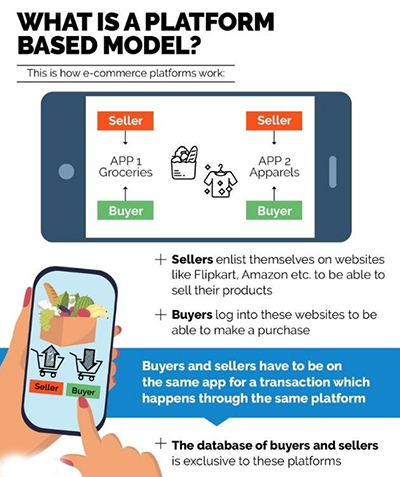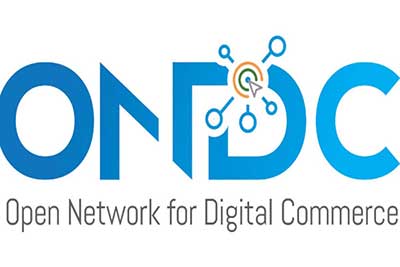Relevance: GS-3: Indian Economy and issues relating to planning, mobilization, of resources, growth, development and employment.
Key Phrases: Department of Promotion of Industry and Internal Trade’s, Open Network for Digital Commerce, E-commerce platforms, Democratise, Platform centric model, Competition, Preferential treatment, Predatory pricing, Lack of clarity, Utilisation of AI-enabled tools, Technological expertise.
Why in News?
- The Department of Promotion of Industry and Internal Trade’s recent pilot of the Open Network for Digital Commerce (ONDC) in five major cities of Delhi, Bhopal, Coimbatore, Bengaluru and Shillong, is a welcome move.
What is Open Network for Digital Commerce (ONDC)?
- ONDC is a freely accessible online system for traders and consumers and it is critical because the government intends to dismantle the digital monopolies and duopolies of giant tech companies such as Amazon, Flipkart, Zomato and others.
- ONDC is a non-profit company whose network will enable the display of products and services from all participating e-commerce platforms in search results across all apps on the network.
- By using any ONDC-compatible application or platform, consumers can discover any seller, product or service, thus giving them freedom of choice.
- The Open Network for Digital Commerce seeks to democratise the e-commerce landscape by facilitating a transparent and impartial online platform for small businesses and start-ups.
- ONDC will act as a neutral platform that will allow products and services from all registered e-commerce businesses and platforms to be displayed together.
- ONDC is a freely accessible government backed platform that aims to democratise e-commerce by moving it from a platform centric model to an open network for buying and selling of goods and services.

What is platform centric model?
- In platform centric model, buyers and sellers have to be on the same app for a transaction which happens through the same platform.
- Sellers enlist themselves on websites like Flipkart, Amazon etc. to be able to sell their products and Buyers log into these websites to be able to make a purchase.
- The database of buyers and sellers is exclusive to these platforms.

What is the significance of ONDC?
- Increase competition:
- The existing platforms work in silos and are tightly controlled, keeping out many small players. It expects ONDC to increase competition and foster innovation by start-ups.
- Bring in logistics firms:
- ONDC will bring in logistics firms and others who can collaborate with sellers to deliver products to customers.
- Focus on small merchants:
- The focus would be on small merchants and rural consumers, with apps in Indian languages.
- Reduce preferential treatment:
- It will help limit the opportunities for selected sellers who receive preferential treatment - a common accusation against major e-commerce companies.
- Rate service providers:
- Users will be able to rate service providers on ONDC, which will be applicable and visible across the network.
- Help to end predatory pricing:
- ONDC will help to end predatory pricing, especially in high-margin, high-value products.
Challenges with Open Network for Digital Commerce:
- Lack of clarity:
- Currently there is a lack of clarity regarding the mechanisms that will govern ONDC, including whether ONDC or the seller will take accountability and responsibility in case of counterfeit or damaged products.
- Utilisation of AI-enabled tools:
- Utilisation of AI-enabled tools, such as chatbots and customer preferences synced with almost every social media and or digital platform of the customer, may present strong challenges to ONDC.
- Lack of technological expertise:
- ONDC aims mainly to tap millions of small businesses that often lack technological expertise, so the government will have to run a massive awareness campaign to get them on board.
- Lack of resources:
- Smaller businesses with low volumes may also lack the resources to match the discounts offered by heavyweights like Amazon and Flipkart.
- Cutting profits from bigger players:
- Giants like Amazon, Zomato and Swiggy have invested billions of dollars in building up their infrastructure and acquiring customers. Now, the government is intervening and has decided that it too wants a piece of the E Commerce pie. so, these companies opposing this.
Government’s other initiatives to boost e-commerce:
- National Retail Policy: The government had identified five
areas in its proposed national retail policy-
- Ease of doing business,
- Rationalisation of the licence process,
- Digitisation of retail,
- Focus on reforms and
- an open network for digital commerce-
- Country of Origin: The Consumer Protection (e-commerce) Rules 2020 notified by the Consumer Affairs Ministry directed e-commerce companies to display the country of origin alongside the product listings. In addition, the companies will also have to reveal parameters that go behind determining product listings on their platforms.
- MoU with Union Bank: Government e-Marketplace (GeM) signed a Memorandum of Understanding (MoU) with Union Bank of India to facilitate a cashless, paperless and transparent payment system for an array of services in October 2019.
- Amending the Equalisation Levy Rules: In October 2020, amending the Equalisation Levy Rules Of 2016, the government mandated foreign companies operating e-commerce platforms in India to have permanent account numbers (PAN). It imposed a 2% tax in the FY21 budget on the sale of goods or delivery of services through a non-resident ecommerce operator.
- Government hiked the limit of FDI: In order to increase the participation of foreign players in E-commerce, Indian Government hiked the limit of FDI in E-commerce marketplace model to up to 100% (in B2B models).
- Rolling out fiber network for 5G: Heavy investment made by the Government in rolling out fiber network for 5G will help boost E-commerce in India.
Way forward:
- Hence, while ONDC is a positive move undertaken by the government to expand India’s digital ecosystem, the concerns on whether the platform itself will be enough for customers to move from established e-commerce platforms that already have served them during the pandemic times need to be addressed. Thus, this calls for greater collaboration between existing and emerging players of the digital ecosystem to build a more robust online retail environment.
Source: The Hindu BL
Mains Question:
Q. Discuss how Open Network for Digital Commerce can democratise the e-commerce landscape platform for small businesses and start-ups.







